![]()
![]()
![]()
Use LEFT and RIGHT arrow keys to navigate between flashcards;
Use UP and DOWN arrow keys to flip the card;
H to show hint;
A reads text to speech;
123 Cards in this Set
- Front
- Back
|
1/8 to decimal |
0.125 |
|
|
0.125 to percent |
12.5% |
|
|
Identify the commonly used units of measurement |
EES SI international system |
|
|
EES Base unit for length mass and time |
Length: foot/ft Mass: pound/lb Time: second/sec |
|
|
SI Base unit for length mass and time |
CGS Length: centimeter/CM Mass: gram/gm Time: second/sec
MKS: Length: meter Mass: kilogram Time: second/sec |
|
|
Value, symbol, and abbreviation for mega |
10x6 M |
|
|
Value, symbol, and abbreviation for kilo |
10x3 k |
|
|
Value, symbol, and abbreviation for hecto |
10x2 h |
|
|
Value, symbol, and abbreviation for deka |
10x1 da |
|
|
Value, symbol, and abbreviation for deci |
10x-1 d |
|
|
Value, symbol, and abbreviation for centi |
10x-2 c |
|
|
Value, symbol, and abbreviation for milli |
10x-3 m |
|
|
Value, symbol, and abbreviation for Micro |
10x-6 u |
|
|
Value, symbol, and abbreviation for nano |
10x-9 n |
|
|
Value, symbol, and abbreviation for pico |
10x-12 p |
|
|
Fahrenheit to Celsius equation |
(F ° -32)/1.8 |
|
|
Celsius to Fahrenheit equation |
1.8(°C) + 32 |
|
|
Celsius to Kelvin equation |
°C+273.15 |
|
|
65 ° F to Celsius |
65 °F-32/1.8 18.3 °C |
|
|
Define work |
A force acting through a distance |
|
|
Define force |
any action on a object that can cause the object to change speed or direction |
|
|
Define energy |
The ability to do work |
|
|
Kinetic energy |
Energy of motion |
|
|
Potential energy |
Is the energy stored in an object as a result of the position or configuration of an object |
|
|
Thermal energy |
The energy that results from the random motion of molecules |
|
|
Chemical energy |
Energy that is derived from atomic and molecular interactions in which new substances are produced |
|
|
Law of conservation of energy |
The total amount of energy in a closed system remains unchanged, as long as no energy leaves the system the amount of energy will always be the same |
|
|
Energy unit |
Joules |
|
|
Thermal energy units |
Calories or BTUs |
|
|
Electrical energy unit |
Kilowatts per hr |
|
|
Work energy relationship |
When work is done by system or object it expends energy |
|
|
Energy can also be converted into mass and mass can be converted into energy |
Energy can also be converted into mass and mass can be converted into energy |
|
|
Matter |
Anything that has mass and takes up space |
|
|
Solid state |
Has definite shape and volume caused by the rigid crystal arrangement of molecules |
|
|
Liquid state |
Indefinite shape and definite volume |
|
|
Gaseous state |
Has an indefinite shape and volume |
|
|
Protons and neutrons |
Protons and neutrons |
|
|
Nuclear forces |
Nuclear forces |
|
|
Electrons that exist in structured orbits around the nucleus |
Electrons that exist in structured orbits around the nucleus |
|
|
Protons charge & mass |
•positively charged •1.6726e-24 gm or 1.007276470 amu |
|
|
Each element is determined by |
The number of protons in the nucleus |
|
|
Neutrons charge & mass |
•neutrally charged •1.6749e-24gm or 1.008665012 amu |
|
|
What determines the isotope of an element |
The number of neutrons |
|
|
What is an isotope |
Atoms that have the same number of protons but different number of neutrons |
|
|
Electrons charge & mass |
•negatively charged •9.1085e-28gm or 0.00054858026 amu |
|
|
Atomic number |
The number of protons in the nucleus of an element |
|
|
Define mass number |
The total number of protons plus neutrons in the nucleus of a particular isotope of an element |
|
|
The actual mass of an isotope |
The actual mass of an isotope |
|
|
Define atomic weight |
The weighted average of the isotopic masses of an element |
|
|
What does A, Z, & X represent in an element |
A: mass number number of protons (Z) plus number of neutrons (N) so a=z+n Z: atomic number: number of protons X: symbol for element |
|
|
Mode of arrangement of elements in the periodic table |
Elements in order of increasing atomic number, |
|
|
Horizontal rows are called |
Periods |
|
|
Columns or vertical sections are called |
Groups or families |
|
|
Valence shell definition |
Highest energy level in an atom that is occupied by an electron |
|
|
Valence electrons definition |
The electrons contained in the valence shell |
|
|
Nucleon |
A constituent particle of the atomic nucleus, either a neutron or proton |
|
|
Nuclide |
A species of an atom characterized by the constitution of its nucleus |
|
|
Isotope |
Nuclides which have the same number of protons but different number of neutrons |
|
|
Mass energy equivalence |
Mass may be transformed to energy and vice versa, they are interchangeable |
|
|
Mass defect |
Total mass of the atom is less than the sum of the masses of the individual protons and neutrons |
|
|
Binding energy |
The energy equivalent of mass defect |
|
|
Binding energy per nucleon |
If the total binding energy in the nucleus is divided by the total number of nucleons in the nucleus |
|
|
Fissioncr |
The splitting of the nucleus into at least two smaller nuclei with an accompanying release of energy |
|
|
Criticality |
The condition in which the neutrons produced by fission are equal to the number of neutrons in the previous generation |
|
|
Fusion |
Acts of combining or fusing two or more and atomic nuclei |
|
|
Identify the 4 sources of natural background radiation and dose received |
1. Terrestrial 18mrem a yr 2. Cosmic 30mrem a yr 3. Internal emitters 30mrem a yr 4. Inhaled radionuclides 229mrem a yr |
|
|
Identify the origin, radionuclides, variables, and contribution of terrestrial background radiation |
Found in soil, rocks, and water Uranium, thorium, potassium 40, rubidium 87 Exposure depends on where you live and the soil and rocks or water supply |
|
|
Identify the origin, radionuclides, variables, and contribution of cosmic background radiation |
Primary: Galactic cosmic rays come from outside the solar system, and solar cosmic rays are produced following severe solar flares on the surface of the sun Secondary: interactions that occur when primary rays reach the atmosphere Estimated dose is 30mrem |
|
|
Identify the origin, radionuclides, variables, and contribution of internal emitters background radiation |
Food chain cycle Potassium 40, rubidium 87, uranium 226, uranium 238, polonium 210, carbon 14 Estimated dose is 30mrem |
|
|
Identify the origin, radionuclides, variables, and contribution of inhaled radionuclides background radiation |
Found in air Radon and thoron Estimated dose is 229 mrem |
|
|
Fallout definition |
Applied to debris that settles to the earth as the result of a nuclear blast |
|
|
5 sources of artificially produced radiation and the magnitude of dose received |
1. Nuclear fallout <1 mrem a yr 2. Medical exposures 300mrem 3. Consumer products 12mrem 4. Industrial occupation 3mrem 5. Nuclear facilities <1 |
|
|
Identify how the neutron to proton ratio is related to nuclear stability |
In a stable atom there’s a balance between attractive and repulsive forces in the nucleus if the forces do not balance out the atom cannot be stable |
|
|
3 forces acting in the nucleus, their interaction, and range |
Gravitational: negligible attractive force between all nucleons it is relatively long Electrostatic: strong repulsive force between like charged particles it is relatively long Nuclear force: strong attractive force between all nucleons |
|
|
Radioactivity definitionrad |
Is manifested by a spontaneous emission of energy from a nucleus that is emission of radiation in the forms of particles and packet of electromagnetic waves |
|
|
Radioactive decay |
The process by which a nucleus spontaneously disintegrates through one or more discrete energy steps until a stable state is reached |
|
|
Characteristics of alpha |
Only relatively heavy radioactive nuclides decay by alpha Consists of 2 neutrons giving a mass of 4 amu Electric charge of +2 Least penetrating of the three types of radiation Shielded by air or paper |
|
|
Alpha decay equation |

Back (Definition) |
|
|
Beta characteristics |
Have same mass as electron (1/1836 of proton) as well as charge is (-1) In nucleus |
|
|
Beta minus decay equation |
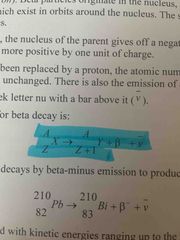
Back (Definition) |
|
|
Gamma characteristics |
Type of electromagnetic radiation Has photons which travel at the speed of light Mev Emitted from the nucleus of unstable atoms |
|
|
Gamma & xray difference |
Gamma is in mev, xrays are in kev Gamma rays are emitted from the nucleus of unstable atoms while xrays originate in the electron shells |
|
|
Gamma equation |
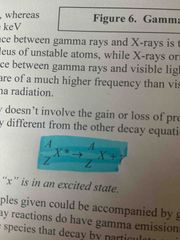
Back (Definition) |
|
|
Beta minus decay characteristics |
Nuclide that has an excess number of neutrons will decay by changing a neutron into.a proton through emission of a negatively charged particle |
|
|
Positron decay (beta plus) characteristics |
Nuclide that has a low n:p ratio Charged particle Found in nucleus |
|
|
Beta minus decay characteristics |
Nuclide that has an excess number of neutrons will decay by changing a neutron into.a proton through emission of a negatively charged particle Charged particle Found in nucleus |
|
|
Positron decay (beta plus) equation |
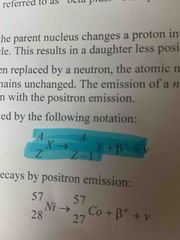
Back (Definition) |
|
|
Electron capture characteristics |
Ratio nuclides having low n:p ratio |
|
|
Electron capture equation |
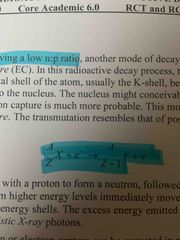
Back (Definition) |
|
|
Identify 4 unique aspects associated with the decay of a radioactive nuclide |
1. Modes of decay 2. Types of emission 3. Energies of the emissions involved 4. Rate of decay |
|
|
Difference between natural and artificial radioactivity |
Heavy radionuclides (natural and artificial) decay by a long series of alpha and beta emissions Lighter artificial radionuclides usually decay by beta or positron emission or by orbital electron capture Lighter artificial produced radionuclides revert to stability in only a few decay steps |
|
|
Why are fission products unstable |
Invariably have too large of a proportion of neutrons to protons for stability and consequently tend to achieve stability by beta emissions |
|
|
3 natural naturally occurring radioactive families and the end product of each |
Uranium series: uranium 238 Thorium series: thorium 232 Actinium series: uranium 235 |
|
|
3 natural naturally occurring radioactive families and the start and end product of each |
Uranium series: uranium 238- 206 PB Thorium series: thorium 232-208PB Actinium series: uranium 235-207Pb |
|
|
Figure out the atomic number, atomic mass, natural percent abundance, stability, half life, and types and energies of radioactive emissions |

Back (Definition) |
|
|
Define cutie |
Represents a very large amount of activity 3.7e10dps 2.22e12 Ci |
|
|
Define becquerel |
Quantity of a radioactive material in which one atom is transformed per second or undergoes exactly 1 DPS Bq 1dps 60dpm |
|
|
Define specific activity |
Activity per unit mass of a radioactive substance and is reported in units such as curies per gram or becquerel per kilogram |
|
|
Define half life |
Time that is required for the activity present to be reduced to half its life |
|
|
Half life equation |
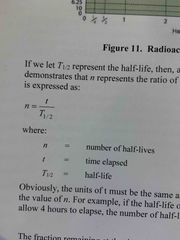
Back (Definition) |
|
|
Radioactive decay equation |
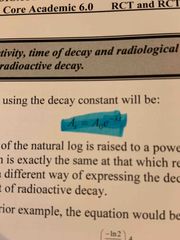
Back (Definition) |
|
|
The half life of the parent is much longer than the half-life of the daughter |
The half life of the parent is much longer than the half-life of the daughter |
|
|
Transient equilibrium |
The half-life of the parent is somewhat longer than that of the daughter |
|
|
No equilibrium |
When the half-life of the parent is shorter than that of the daughter the two never reached a state of equilibrium |
|
|
Define exposure |
is a measure of the ability of photons to produce ionization in air |
|
|
Define ionization |
Any process that results in the removal of a bound electron from an electrically neutral atom or molecule by adding enough energy to the electron to overcome it’s binding energy |
|
|
Define excitation |
Any process that has enough energy to an electron of an atom or molecule so that it occupies a higher state then it’s the lowest bound energy state |
|
|
Define bremsstrahlung |
Radioactive energy loss of moving charged particles as they interact with the matter through which they are moving |
|
|
Radiation weighting factors |
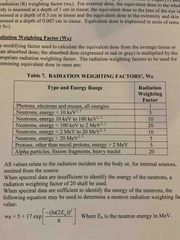
Back (Definition) |
|
|
Define linear energy transfer |
Average energy locally deposit in an absorber resulting from a charged particle per unit distance of travel |
|
|
Stopping power definition |
The ability to remove energy from a beam of charged particles |
|
|
Define range |
Charged particles whose energy is kinetic energy which is lost continuously along their path |
|
|
Define w value |
The average amount of energy needed to create an Ion pair in a given medium W eV/ion pair |
|
|
Define absorbed dose |
Measure the amount of radiation energy absorbed or deposited per unit of mass |
|
|
Equivalent dose definition |
The product of average absorbed dose in rad or gray in a tissue or organ and the radiation weighting factor 1cm whole body Eye lenses 0.3cm Extremities and skin 0.007cm |
|
|
The modifying factor used to calculate the equivalent dose from the average tissue or organ absorbed dose |
The modifying factor used to calculate the equivalent dose from the average tissue or organ absorbed dose |
|
|
Radiation weighting factors |
Back (Definition) |
|
|
Define specific ionization |
The number of ion pairs formed by the particle per unit path length and is often used when the energy loss is continuous and constant such as with beta particles or alpha particles S.I. Ion pairs/cm |
|
|
Define linear energy transfer |
Average energy locally deposit in an absorber resulting from a charged particle per unit distance of travel LET keV/cm |
|
|
Stopping power definition |
For a given absorber the average energy lost by a charged particle per unit distance traveled S keV/cm |
|
|
Define rem |
Traditional unit of equipment dose is an acronym for roentgen equivalent man it is a quantity of ionizing radiation whose biologic effect is equal to the produce by 1 rad of x-rays or gamma radiation |
|
|
Define the sievert |
The SI unit of equivalent dose it is equal to the absorbed dose in grays multiplied by the radiation factor GrayxQ |
|
|
Define range |
Average distance traveled by a radiation in an absorbing medium R Cm |

